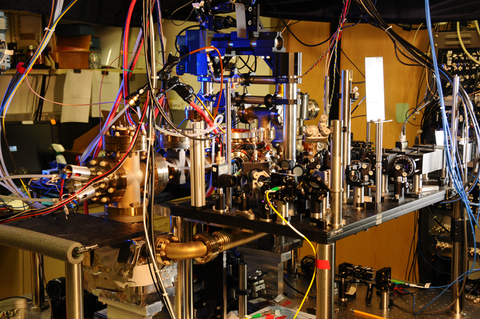Summary
The very best atomic clocks today are known as optical clocks, because their timebase resides at a very high frequency (~1015 Hz), corresponding to the optical domain of the electromagnetic spectrum.
Description

NIST Yb optical lattice clock
In recent years, optical clocks have achieved performance that is orders of magnitude beyond more traditional atomic clocks utilizing a microwave timebase. A particularly promising type of advanced optical clock is the optical lattice clock. At their heart, these systems use an ensemble of ultracold, laser-cooled atoms confined in a periodic laser trap known as an optical lattice. A number of atomic species are well-suited for use in optical lattice clocks, and we are developing them with 171Yb (ytterbium). NIST Yb lattice clocks push the frontiers of atomic timekeeping, and have set world records in the most critical figure-of-merits for optical clocks including frequency stability, systematic uncertainty, and reproducibility. For example, comparisons between two Yb lattice clocks have demonstrated consistency with a total fractional frequency uncertainty of 1x10-18. These clocks are also frequently measured with and compared to other optical and microwave clocks at NIST and beyond. These cross-species comparisons play a critical role in efforts to update and re-define our standard unit of time, the SI second. We also leverage the extreme precision that these type of measurements realize in order to test fundamental laws of physics, including searches for physics beyond the Standard Model. In the quest to make these clocks even more precise, we actively research new quantum control and measurement techniques, new laser-cooling strategies, extreme laser stabilization, ultra-coherent light-atom interactions, and enhanced control of systematic effects that impact the fundamental limits of optical clocks.
Relevant Publications
X. Zhang et al., “Subrecoil Clock-Transition Laser Cooling Enabling Shallow Optical Lattice Clocks,” Phys. Rev. Lett. 129 113202 (2022).
M. E. Kim et al., “Improved interspecies optical clock comparisons through differential spectroscopy,” Nature Physics 19 25 (2023).
BACON collaboration et al., “Frequency ratio measurements at 18-digit Accuracy using an optical clock network,” Nature 591 564 (2021).
T. Nakamura et al., “Coherent optical clock down-conversion for microwave frequencies with 10-18 instability,” Science 368 889 (2020).
J. Yao et al., “Optical-Clock-Based Time Scale,” Physical Review Applied 12 044069 (2019).
W. McGrew et al., “Towards the optical second: verifying optical clocks at the SI limit,” Optica 6 448 (2019).
P. Wcislo et al., “New bounds on dark matter coupling from a global network of optical atomic clocks,” Science Advances 4 12 (2018).
W. McGrew et al., “Atomic clock performance enabling geodesy below the centimeter level,” Nature 564 87 (2018).
K. Beloy et al., “A Faraday-shielded, DC Stark-free optical lattice clock,” Phys. Rev. Lett. 120 183201 (2018).
R. C. Brown et al., “Hyperpolarizability and operational magic wavelength in an optical lattice clock”, Phys. Rev. Lett. 119 253001 (2017).
M. Schioppo et al., “Ultrastable optical clock with two cold-atom ensembles,” Nature Photonics 11 48 (2017).
A. D. Ludlow et al., “Optical Atomic Clocks,” Rev. Mod. Phys 87 637-701 (2015).
K. Beloy et al., “Atomic Clock with 1x10-18 Room-Temperature Blackbody Stark Uncertainty,” Phys. Rev. Lett. 113 260801 (2014).
A. M. Rey et al., “Probing many-body interactions in an optical lattice clock,” Annals of Physics 340 311-351 (2014).
N. Hinkley et al., “An atomic clock with 10-18 instability,” Science 341 1215-1218 (2013)

